A long time ago, when I posted the difference and between muslin, voile, lawn, and batiste (among other fabrics), someone asked if I could explain the difference between brocade and jacquard. I took a deep breath, and say “Yes, but it will take a while.” It certainly has, because it’s actually quite a big question, and there is so much confusion around it!
A lot of the confusion come from the fact that while the appearance of brocade has stayed very similar throughout history, the method of creating it has changed drastically. Prior to 1801 brocades were woven on hand operated draw-looms by master weavers, who manually created the elaborate brocade patterns as they were woven in with the help of a drawboy, who stood on a perch above the loom. Then, in 1801 Joseph Marie Jacquard demonstrated a new invention (albeit one based partly on a series of inventions from the 1740s-60s) – a loom which ran on cards with holes punched in them. Each card represented one line of a pattern, with the holes allowing threads to pass through into the pattern, changing the colours and creating a design.
The Jacquard loom revolutionised the production of elaborately patterned fabrics. Skilled craftsmen who could read pattern diagrams and manipulate the pattern as it was being woven were no longer needed to weave brocades and other designs, and the Jacquard loom did not require the assistance of an additional drawboy. The new looms could be operated by an unskilled labourer, making richly patterned fabrics faster and cheaper to produce. Jacquard looms were so much easier and cheaper to operate that the old style of looms quickly became obsolete, and within a few decades of Jacquard’s invention almost all elaborate fabrics woven in the West, including brocades, damasks, and richly patterned faux-Kashmiri or ‘Paisley’ shawls, were woven on Jacquard looms.
If the punch cards with holes which create a pattern sounds a little like an early computer – it is. The Jacquard loom and its punch card pattern system is considered an important point in the history of the computer. Babbage and Lovelace (the ‘Father of the Computer’ and world’s first computer programmer and first person to envision a computer that did much more than mathematical calculations (also Byron’s daughter), respectively) were familiar with Jacquards loom, and Babbage intended to use punch cards based on the loom punch cards in his Analytical Engine.
The jacquard loom was further revolutionised in 1843, with the invention of the dobby loom, which makes simpler patterned fabrics by a method of up to 40 frames which lift according to a programme. The dobby loom was even cheaper to run than the Jacquard, and supplanted it for all simpler patterned weaves. Dobby loom patterns, however, are limited to designs that stretch over 40 threads, whereas designs made on a Jacquard loom are virtually limitless. Today jacquard weaves are achieved not with a Jacquard loom, but rather a Jacquard head which is fitted on to a dobby loom.
Almost all modern brocades are woven with a jacquard device, so one could say that all modern brocades are jacquards, but not all jacquards are brocades, because jacquard looms are used to create other weaves, such as brocatelle, damask and tapestry.
Today the name jacquard usually applies to all weaves that can be achieved with the machine, but it is sometimes used to describe one specific type of fabric woven using a Jacquard loom: a light, soft, draping damask weave (see damask weaves below) of silk, rayon or synthetic fibres, which is why descriptions of jacquard as a fabric sometimes say daft things like ‘similar in appearance to damask’.
Here are some of the most common weaves achieved on a jacquard loom. Because a jacquard head can produce an almost infinite variety of weaves, there are many fabrics produced with a jacquard loom that don’t fit nicely into one weave category or another, so certain fabrics (particularly brocade & tapestry) can be quite fluid or imprecise in their definition:
Brocade: These days brocade frequently describes the aesthetic of a fabric, rather than a specific weave. Brocades are fabric with an elaborate embossed or embroidered surface effect, usually with different ground and pattern weaves. The name comes from the Italian brocatto, meaning ’embossed cloth’. Unlike damask, brocades are not reversible. Continuous brocades have the weft threads left loose and floating on the back. Some continuous brocades have the back threads cut away, though the short cut ends are still visible. A discontinuous brocade is one where additional yarns are only woven into the patterned areas, resulting in a smoother back.

A continuous brocade with a pattern formed of lame threads that have been cut on the reverse of the fabric.
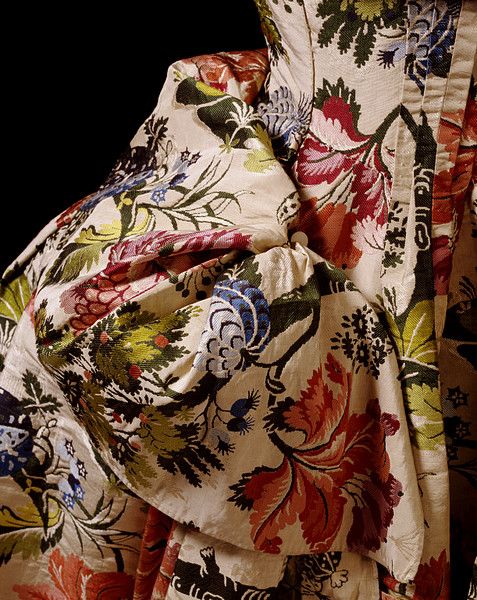
Mantua, England, 1733-1734 (woven) 1735-1740 (made), Brocaded silk, hand-sewn with spun silk and spun threads, lined with linen, brown paper lining for cuffs, brass, canvas and pleated silk detail, Victoria & Albert Museum
Brocading: brocade or other jacquard weaves with the inclusion of gold or silver coloured threads. It is also called Imperial Brocade.
Brocade velvet: a patterned velvet with a raised pile and a woven ground (not to be confused with a burnout velvet, where the patterning is achieved by burning out the pile with acid, rather than weaving in the pattern from the start).
Brocatelle: Similar to brocade, but the patterned areas are more distinct and raised, and the fabric is heavier.
Damask: Patterned fabrics with a ground of one weave (usually plain, twill or sateen) and designs in other weaves (particularly satin and twill variants), so that the patterned areas have sheen and reflect light, Damasks are always reversible, with the pattern weaves becoming the ground weaves on the reverse (so on a fabric with a plain ground and satin pattern front, the ground would be satin and the pattern plain on the reverse). There are tone-on-tone damasks, with different weaves within the damask creating elaborate floral or geometric patterns, and multicoloured damasks, where the background colours and the pattern colours reverse from front to back. My Polly Oliver jacket is made from a red tone-on-tone jacquard damask.

Tea gown with 18th century inspired back pleats, ca. 1905, Callot Soeurs, silk damask, lace, Victoria & Albert Museum
Matelasse/Marcella/Pique: a weave specifically designed to imitate quilting with a characteristic bubbled/blistered raised effect.
Tapestry: In modern terminology ‘tapestry’ just means a fabric woven on a jacquard loom that imitates historical tapestries. It’s a very imprecise term, but it describes a heavy fabric with an elaborate, multicolour weave, usually with the colours reversing on the back of the fabric (for example, a fabric with green leaves on a red ground would have red leaves on a green ground on the reverse), but is thicker, stiffer, and heavier than damask, the reverse may not be as neat and tidy, and is usually woven with thicker yarns than damask or brocade.
If you are looking at a modern jacquard weave fabric and trying to determine what it is most likely to be called, ask yourself:
– Is it reversible, with the pattern a mirror of each other on each side? If so – it’s a damask. If it’s light and drapey, some people might call it a jacquard.
– Is one side beautiful, and the other side a mess of floating threads? It’s a continuous brocade, unless it’s very heavy, and the pattern is very raised, and then it is a brocatelle.
– Is one side beautiful, and the other a mess of short, cut threads? Its a discontinuous brocade, unless it’s very heavy, and the pattern is very raised, and then it is a brocatelle.
– Is one side beautiful, and the other a pattern of coloured stripes? It’s a type of brocade.
– Is it a brocade with gold and/or silver coloured threads? It’s an imperial brocade/brocade with brocading.
– Is it quite textured, with puffy, blistered areas on the front and a loose, gauzy support weave on the back? It’s a matelasse/marcelle/pique
– Is it really elaborately patterned, quite heavy, and doesn’t fit any of the other descriptions? It’s a tapestry weave.
Jacquard looms can also be used to create elaborately patterned knits, including:
Jacquard hose: socks and stockings with elaborate patterns, such as argyle, herringbone, and other socks with the patterns woven in. Stockings/socks/hose have been knit on jacquard looms since the 1920s, and have gone in and out of popularity since then.
Jacquard sweaters: machine made sweaters with elaborate patterns knitted in. Most ugly Christmas sweaters? Yep. Those are jacquard sweaters. Aztec sweaters – those are jacquard sweaters. Machine knit argyle sweaters are knit on a jacquard loom. Faux Fair Isle and Cowichan sweaters are knit on jacquard looms.
And if you are interested, weaves that are usually done with a dobby loom are birds eye (diaper cloth), crepes, cloche, dotted swiss, double-weaves, honeycomb weaves, simple matelasse/pique patterns, satins, and elaborate twills, as well as fabrics with small, simple widely spaced designs.
Sources:
Cant, Jennifer and Fritz, Anne, Consumer Textiles. Melbourne: Oxford University Press. 1988
Calasibetta, C. M., Tortora, P, and Abling, B (illus.). The Fairchild Dictionary of Fashion (Third Ed). London: Laurence King Publishing Ltd. 2003
Collier, Billie J. and Tortora, Phyllis G. Understanding Textiles (Sixth ed). Upper Saddle River, New Jersey: Prentice Hall Inc. 2001
Shaeffer, Claire. Claire Shaeffer’s Fabric Sewing Guide. Iola, Wisconsin: Krause Publications. 2008
Wilard, Dana. The Fabric Selector. Millers Point, NSW Australia: Murdoch Books Pty Ltd. 2012

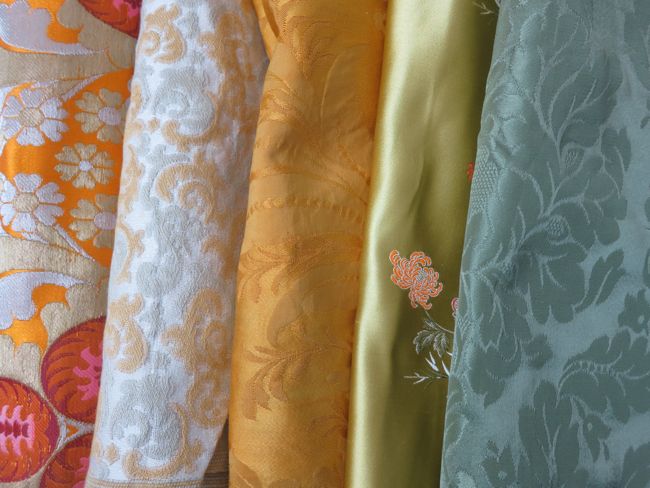
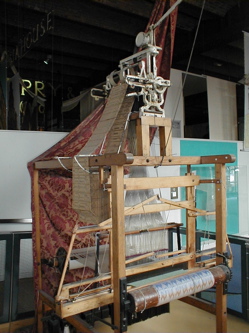


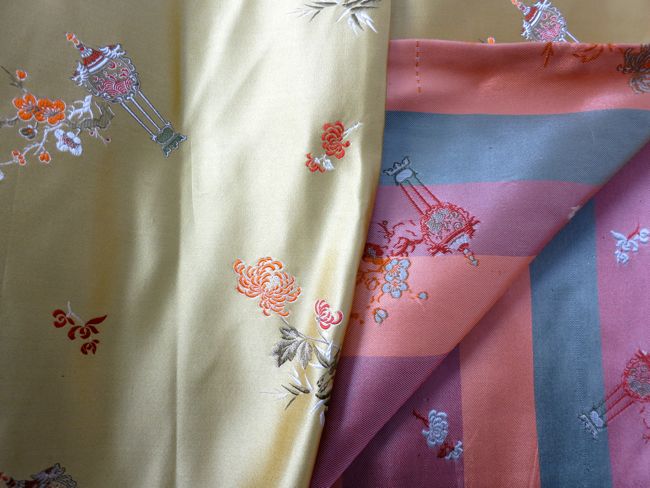
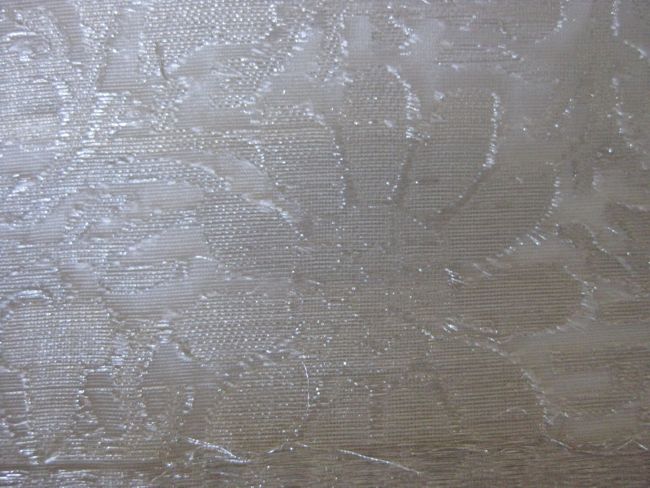



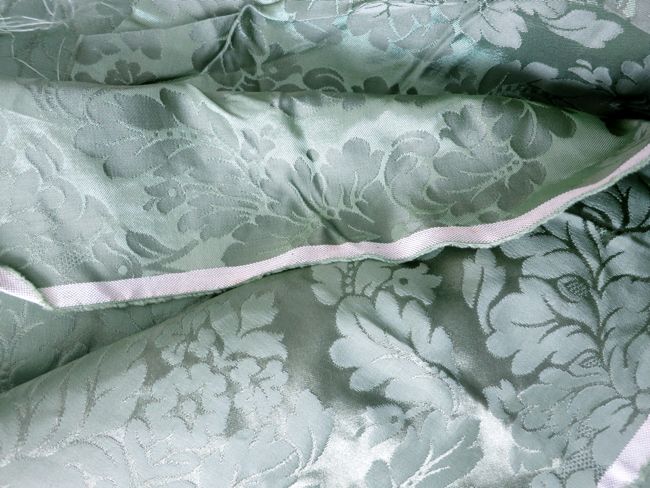


As you’ve already pointed out, brocade and jacquard are completely different things, while the first names a kind of fabric, the second is a technique, a loom add-on, if you wish.
And the term brocade is a little complicated itself, the CIETA (Centre International d’Etude des textiles anciens) advises not to use because it says very little about technique and material, there are better and more specific terms (the CIETA publishes a vocabulary with all the common terms, explanations and it is used by many museums with textile museums worldwide).
The Jacquard mechanism was only the most successful invention in a row of attemps to reduce the work that had to be done when creating complex patterned fabrics, its predecessor was the “semple” on the great drawstring loom, this being still completely hand operated. Already in the 18th century a lyonese silk merchant managed to seperate this pattern-creating-unit from the loom itself and invented a machine to “program” the semple without occupying the loom.
(sorry to be such a know-it-all, but I wrote my MA-Dissertation on 18th-century french silk weaving and especially this very merchant, who invented the new kind of “semple”, Philippe de Lasalle, so I am constantly fighting to grow awareness for this row of events that only experienced its climax in the Jacquard-mechanic).
greets, ette
Thanks for your additional information! I do mention that the Jacquard loom was based on earlier inventions, but I didn’t want to complicate the post any more than necessary, as the main point was explain the difference between the weaves and technique in modern usage.
As I noted, brocade can be an imprecise term, and although CIETA may recommend against it, there are still many museums that use it (such as the V&A), and any seamstress, historical or otherwise, is going to encounter the term in fabric stores and sewing books, so it’s helpful to understand what the fabric stores and sewing books are attempting to describe, even if they are less than precise in their usage. This is also why I mentioned the use of ‘jacquard’ to describe a particular look and hand of fabric, even if the usage is a little ridiculous. Sometimes we have to work with the commonly held term, as well as advocating for better ones.
And I don’t mind a know it all, as long as they actually do! 😉 Perhaps you should write a blog post about the semple, as an add-on to this?
Sorry, didn’t want to sound as if I was correcting you, I saw that you mentioned it. Please understand my comment more to be complementary.
I know at least of two Cieta-members working in the V&A, but I assume it is always a tough decision between using technical terms only very few understand and chosing less precise terms, that at least evoke an association in most minds. So I can understand the museum’s decision to keep using this word.
I am indeed planning some posts on weaving theory, but they are pretty complicated to write, I don’t want to use images that weren’t made by me and I do already observe in direct talk, how difficult it is to explain and make understand weaving in theory, not talking about complex, patterned designs yet. So it is a challenge I am still working on 🙂
Wow, what fantastic information. I have learnt a lot!
Thanks! I’m very glad it was helpful!
This is fascinating – thank you for sharing! I love working with lovely textured fabrics . . . I just wish they were easier to come across.
I’m not kidding you when I say that at least once a week, I think “I must find out the difference between brocade and jacquard”. And now you’ve done all the heavy lifting! Great work, and thank you!
Phew. I’ve been naming damask correctly. *oozes relief* And this explains why some damasks are colourful, too, which was something I could not quite grasp.
Thank you so much for writing this. I wasn’t the person initially asking, but it was confusing me a bit as well!
‘Damask’ is an Arabic word & I always wondered how it originated.
Behold!
The oracle of Wikipedia-
Damasks derive their name from the city of Damascus – in that period a large city active both in trading (as part of the silk road) and in manufacture.
The production of damask used one of the five basic weaving techniques of the Byzantine and Islamic weaving centres of the early Middle Ages.
Damasks became scarce after the ninth century outside of Islamic Spain, but were revived [by whom?] in some places in the thirteenth century.
The word “damask” first appeared in records in a Western European language in the mid-14th century in French.
By the fourteenth century damasks were being woven on draw looms in Italy.
Fascinating.
Most of these classic repeating floral designs originated in Islamic cultures with depictions of humans & animals being ‘haram’ in Islam.
Most of the famous brocades of India are Mughlai inspired intricate intertwining floral and foliate motifs – such as the gorgeous hand loomed silk sarees still woven in Benares.
The city and the fabric are actually the same word in Czech, differentiated only by capital D for the city!
I enjoyed this. I did not know that Byron’s daughter’s mathematical and programming feats had a loom in the background.
Aside: the word “hand” with regard to fabrics is such a wonderful way of describing it.
Hand is a lovely way to describe fabric, but quite imprecise! I use it because everyone knows it, but when I am teaching technical textile courses we have a set of terms which are more precise and scientifically measurable, so that everyone knows exactly what we are talking about – sort of like the Pantone colours of fabric hand!
I once came across some very nice punchcard loom pictures on a site about Lovelace and Babbage.
http://sydneypadua.com/2dgoggles/more-punchycards/
Besides the looms, they have a machine for punching the cards, and another for stringing them together.
Ah, Lovelace and Babbage. I think someone linked to it in the comments here before. Since then, I’ve been eagerly awaiting new comics, and none are coming, because apparently a book is coming instead. It’s awesome. All the mathematics go happily over my head, but I love the whole absurd humour of it. Immedieately as Leimomi mentioned the looms, I thought of that, too!
So at the moment I have a cheap acrylic faux -pashmina draped over the back of my office chair. It’s loosely woven from four colours of thread – yellow and black in the warp and blue and red in the weft.
The pattern is formed from the possible combinations of those colours – yellow/blue, yellow/red, black/blue and black/red. The scarf is essentially two layers of cloth, held together where you get a transition between one colour mix and another. Where there is a largish patch of one mix, you can pull the layers apart and feel that there is a pocket between them.
This must have been made using some sort of jacquard-like process – is there any term for double layer fabrics like this?
I have a very similar scarf, and was just thinking about it, and where it fits into the jacquard process. It’s definitely made with a jacquard head, and I think that technically speaking, its somewhere between a continuous brocade and a damask. Those scarves are an example of the infinite variety of weaves a jacquard head can achieve!
That was excellent, and I think I know more now about brocade and jacquard and their children.
But I am now aware of terminology traps – stressful for a fusspot who like to ‘get it right’, so I feel a bit like the centipede.
For anyone who does not know the wee poem:
A centipede was happy, quite, until a frog, in fun,
Said, “Pray, which leg comes after which?”
This raised her mind to such a pitch
She lay distracted in the ditch,
Unable then to run.
tienchiu.comtienchiu.comHead over to http://www.tienchiu.com She just spent a week learning to design and weave on a Jacquard loom. Her blog has some very nice posts on the topic.
This is a great article. With your knits sweater section, I would further specify the difference between patterns made using jacquard techniques and patterns made using intarsia. Knit jacquard is double sided and is a rib structure where the pattern floats are hidden on the backside within the rib. Intarsia is one sided and floats are completely eliminated. Argyle is an example of intarsia not jacquard. Intarsia used to be done on hand looms but now can be done on super fancy computerized machines.
I’ve been looking at this closeout fabric I have and was wondering whether it was a brocade, damask, jacquard, etc…and now I know it’s a damask! Thanks so much for your timely post =o)
[…] For your inner fabric geek (admit it–we’re all secretly fabric geeks): if you’ve ever wondered about the difference between a brocade and a jacquard, here’s really clear and thorough explanation. […]
[WORDPRESS HASHCASH] The comment’s server IP (74.121.232.215) doesn’t match the comment’s URL host IP (74.121.234.39) and so is spam.
Bravo ! Very informative and neatly woven in words too. Thanks for this.
Thanks for the good research and article.
Nicely done!
Wow, thanks you for the detailed description of each. I was looking for a description of what a brocade dress was because I was reading a fairytale to my daughter ( Beauty and the Beast). The first daughter asked her father for a brocade dress, but when she said, Whaz dat Mummy? I was clueless (thankfully goodness for the Internet). I was able to show her the fabric and the dresses that you posted in your summary and actually described what this term mint. Now she thanks I’m still pretty smart Kama like I said thank goodness for the internet and for people like you that take the time to help those of us who lack knowledge in every subject that a 4 yr old brain conjures for their poor parents lol 🙂
By far the clearest explanation yet. Thanks heaps
Hello Leimomi, Thank you. As Angie and others said, the definitions you gave are simple and the pictures are great.